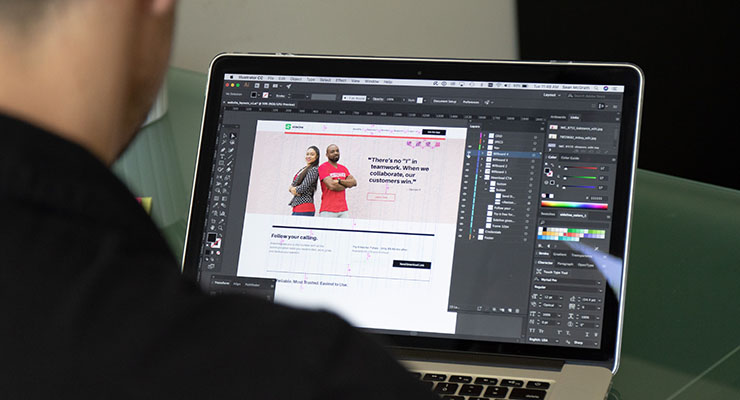We sat down with Sean McGrath, VP of Design, to hear about his creative approach to Sideline’s 2018 website redesign.
Q: Can you tell us about your role at Sideline?
A: I essentially oversee design across every aspect of the organization, from our identity to our product interface and, of course, our marketing efforts and website design. A big part of my role is making sure we’re staying true to our brand mission and delivering a cohesive, beneficial experience for our customers.
Hearing firsthand how people were using the product in ways that we didn’t initially foresee was truly inspiring.
Q: During this redesign process, was there anything that surprised you?
A: As we began working on the website, we knew that spending time with our customers and hearing their stories would be worthwhile. But hearing firsthand how people were using the product in ways that we didn’t initially foresee was truly inspiring. For example, a popular musician, Mikey Mike, placed his Sideline number on a billboard with some provocative advertising and was inviting his fans to text and interact with him directly. Throughout the whole design process, it became even clearer that we want to be a true partner for our customers. It might sound cheesy, but we see Sideline as having the potential to help them realize their dreams—whether that’s to explore a hobby, work a side gig, or build a successful business.

Q: For Sideline’s new website design, can you walk us through some of the reasoning behind the decisions you made?
A: Sure. At a high level, we wanted to tell our story through our customers’ experiences with the product. We felt that hearing directly from people like them—versus from a brand they might not be familiar with—was a more authentic, compelling, and relatable way for website visitors to understand what Sideline can do. And in doing so, we’re able to share our users’ incredible stories and promote their businesses as well.
On top of that, our goal was to emphasize the value and benefits of Sideline over merely describing the feature set. And the challenge with that was making those benefits relevant to different types of customers. For example, a small business with 5 team members uses Sideline very differently than, say, someone who just wants to keep their personal number private. We made sure all the customers we featured were portrayed as unique individuals first and foremost, even if they used Sideline in a business capacity. After all, business owners are still just people, so we wanted our photography to portray all of our users equally as such.
We built Sideline to save people time so they could focus on doing what they love.
Q: What other decisions went into the way you approached customer photography?
A: There were a few things. As I mentioned, we tried to photograph everyone as a person first and a business second.
But we also tried to capture their lifestyles. They all have such a broad spectrum of backgrounds. Each of their businesses are at various stages in size and vary in industry. But what they all had in common was this contagious passion for whatever they do. They loved sharing how they got started as much as we loved hearing about it. We tried to capture that passion in the photos.
And finally, we intentionally didn’t want to showcase our customers with phones in their hands. Like any small business owner, they’re extremely busy—often times too busy to keep up with calls and texts. Part of what our customers love about Sideline is the fact that it works for them in the background. Whether it’s Auto-Reply, Team Number, or our voicemail features, we built Sideline to save people time so they could focus on doing what they love. It’s something we think about every day when designing new features and working to improve Sideline.
Staying focused on the problem that needs to be solved and the value that needs to be to provided is always important.
Q: Can you give us some additional insight into your creative process?
A: Well, there’s one principle we try to apply everywhere, which is to always put ourselves in our customers’ shoes. Staying focused on the problem that needs to be solved and the value that needs to be provided is always important, especially in user interface design. It’s easy for us to think about what we want to communicate about the company and our products. But more often than not, we’re so immersed in our work that it’s easy to forget our audience doesn’t have the same background information or context. As a part of the creative process, it’s crucial to step back and make sure our visual and written communication speaks to our customers’ needs in ways they can clearly and immediately understand.
![]()
Get Featured!
We’re always looking for new professionals to feature throughout our website and blog. If you are a Sideline user and want to share your story, fill out the form below for a chance to have your business featured!
As always, follow us on Facebook, Instagram, and Twitter to keep up
with everything that’s happening in the Sideline community.








